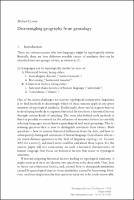Chapter Disentangling geography from genealogy
| dc.contributor.author | Cysouw, Michael | |
| dc.contributor.editor | Auer, Peter | |
| dc.contributor.editor | Hilpert, Martin | |
| dc.contributor.editor | Stukenbrock, Anja | |
| dc.contributor.editor | Szmrecsanyi, Benedikt | |
| dc.date.accessioned | 2019-11-19 23:55 | |
| dc.date.accessioned | 2020-01-07 16:47:06 | |
| dc.date.accessioned | 2020-04-01T09:26:33Z | |
| dc.date.available | 2020-04-01T09:26:33Z | |
| dc.date.issued | 2013 | |
| dc.identifier | 1006434 | |
| dc.identifier | OCN: 1135847150 | en_US |
| dc.identifier.uri | http://library.oapen.org/handle/20.500.12657/23710 | |
| dc.description.abstract | In this paper I will not seek to settle this question for individual cases of shared characteristics between two specific languages (e.g. why do French and German have no distance contrast in demonstratives?; see Diessel 2008;Cysouw 2011), because individual historical developments cannot be predicted by a general theory of human language. Specific historical events can only be reconstructed by an in-depth investigation of the actual history of a specific situation. However, I propose that the influence of borrowing vis-à-vis genealogical descent can be investigated in the aggregate (cf. Nerbonne and Siedle 2005; Nerbonne 2009 on the notion “aggregate”).To investigate the relationship between typological structure, genealogical descent, and borrowing, I will use data from the World Atlas of Language Structures (WALS, Haspelmath et al. 2005). This resource provides information about typological structure and genealogical descent, but not about possible contact or the probability of borrowing. To approach the probability of borrowing, I will use the present-day geographical distribution of languages, assuming that the probability of borrowing is inversely correlated with geo-graphical distance. Specifically, geographically close languages will have a higher probability of contact, and likewise a higher probability of borrowing. | |
| dc.language | English | |
| dc.subject.classification | thema EDItEUR::C Language and Linguistics::CF Linguistics | en_US |
| dc.subject.classification | thema EDItEUR::C Language and Linguistics::CF Linguistics::CFF Historical and comparative linguistics::CFFD Dialect, slang and jargon | en_US |
| dc.subject.classification | thema EDItEUR::C Language and Linguistics::CF Linguistics::CFG Semantics, discourse analysis, stylistics | en_US |
| dc.subject.other | Space | |
| dc.subject.other | Geolinguistics | |
| dc.subject.other | Interaction | |
| dc.subject.other | Cognition | |
| dc.title | Chapter Disentangling geography from genealogy | |
| dc.type | chapter | |
| oapen.identifier.doi | 10.1515/9783110312027.21 | |
| oapen.relation.isPublishedBy | 2b386f62-fc18-4108-bcf1-ade3ed4cf2f3 | |
| oapen.relation.isPartOfBook | b7a963b6-a53f-4752-b9f9-74ec106f4a0e | |
| oapen.relation.isFundedBy | 7292b17b-f01a-4016-94d3-d7fb5ef9fb79 | |
| oapen.relation.isbn | 9783110311969 | |
| oapen.collection | European Research Council (ERC) | |
| oapen.place.publication | Berlin/Boston | |
| oapen.grant.number | 240816 | |
| oapen.grant.acronym | QUANTHISTLING | |
| oapen.identifier.ocn | 1135847150 |

